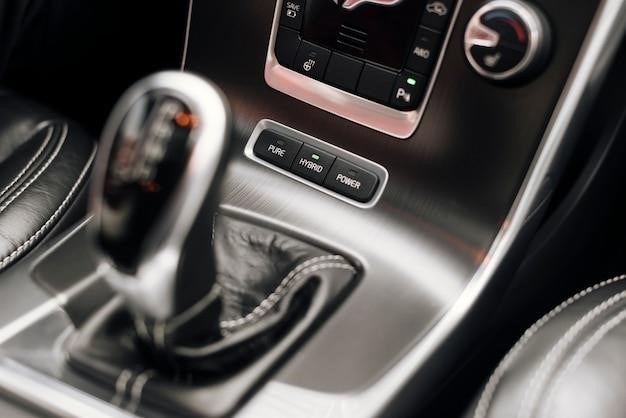G56 Manual Transmission⁚ A Comprehensive Guide
The G56 manual transmission is a heavy-duty longitudinal gearbox designed for use in trucks. Introduced in 2005, it replaced the New Venture Gear 5600 transmission in Dodge Ram 2500 through 5500 pickup and chassis-cab trucks. The G56 is known for its smooth and quiet operation, a significant improvement over its predecessor. It was a popular option for Ram owners who prefer a manual transmission for its control and driver engagement. The G56 transmission was discontinued in 2018, with automatic transmissions becoming the standard offering. This guide will explore the history, technical specifications, performance, and other aspects of the G56 transmission.
Introduction

The G56 manual transmission, a six-speed marvel engineered by Mercedes-Benz, emerged as a game-changer in the realm of heavy-duty trucks. This robust gearbox, designed to handle the demands of towing and hauling, found its home in the Dodge Ram 2500, 3500, 4500, and 5500 pickup trucks and chassis cabs from 2005 to 2018. It marked a departure from the cast-iron New Venture Gear 5600 transmission, offering a lighter, more refined, and smoother shifting experience. The G56’s reputation for durability and performance made it a favorite among Ram owners seeking a manual transmission for its inherent control and driving engagement. However, the era of the G56 ended in 2018 as automatic transmissions gained prominence in the heavy-duty truck market. Despite its absence from newer Ram models, the G56 remains a significant part of the truck world, leaving a lasting impact on the driving experience for countless owners. This comprehensive guide delves into the fascinating history, technical specifications, performance, and other aspects of this iconic transmission.
History and Development
The G56 transmission’s journey began in the mid-2000s as a response to the limitations of the existing New Venture Gear 5600 (NV5600) transmission. The NV5600, a heavy-duty, cast-iron gearbox, faced challenges with durability, noise, and shifting smoothness. Dodge Ram, seeking a more refined and reliable transmission for its heavy-duty trucks, turned to Mercedes-Benz for a solution. The result was the G56, a six-speed manual transmission built with an aluminum case, offering significant weight reduction and improved smoothness. Introduced in 2005 alongside the NV5600, the G56 quickly gained popularity, proving its superiority in terms of shifting feel, quiet operation, and overall performance. It became the only manual transmission offered in the Dodge Ram 2500 and 3500 series trucks for several years, further solidifying its status as a top choice for heavy-duty truck owners seeking a manual transmission experience. However, the rise of automatic transmissions and their increasing efficiency led to the G56’s eventual discontinuation in 2018, marking the end of an era for manual transmission enthusiasts.
Applications and Compatibility
The G56 transmission found its home primarily in Dodge Ram trucks, specifically the heavy-duty 2500, 3500, 4500, and 5500 models. Its compatibility extended across various model years, from 2005 to 2018. The G56 was designed to handle the power and torque output of the Cummins diesel engine, making it an ideal pairing for these heavy-duty trucks. Its robust construction allowed it to withstand the rigors of towing and hauling heavy loads, making it a popular choice for those who rely on their trucks for work or recreational purposes. Beyond the Dodge Ram lineup, the G56 transmission has been used in some commercial truck applications, demonstrating its versatility and reliability. However, its primary application remains within the Dodge Ram heavy-duty truck segment, where it cemented its reputation as a capable and durable transmission option. With its specific design and intended application, the G56 transmission has left a mark on the heavy-duty truck market, showcasing its ability to handle demanding tasks and providing a reliable driving experience for those who prefer a manual transmission.
Technical Specifications
The G56 transmission, a product of Getrag, boasts a robust design built for heavy-duty applications. It features a six-speed manual transmission with synchronized gears, ensuring smooth transitions between gears. The G56 is known for its durability and ability to handle high torque loads, making it a suitable match for the powerful Cummins diesel engines found in Dodge Ram trucks. The transmission’s construction includes an aluminum case, which contributes to its relatively lightweight nature compared to its predecessor, the NV5600. This design choice not only enhances efficiency but also contributes to improved handling and overall vehicle performance. The G56 transmission is equipped with a dual mass flywheel, which helps to minimize noise and vibration, enhancing the overall driving experience. This technical aspect further solidifies the G56’s reputation as a well-engineered transmission, capable of delivering both power and refinement in demanding applications.
Gear Ratios
The G56 transmission’s gear ratios are carefully chosen to optimize performance and fuel efficiency across various driving scenarios. The ratios are designed to provide both strong acceleration and efficient cruising on the highway. The first gear ratio is relatively low, providing strong launch capabilities for heavy loads. The following gears are progressively higher, allowing for efficient acceleration and cruising at higher speeds. The final overdrive gear helps to reduce engine RPM at highway speeds, contributing to improved fuel economy. The specific gear ratios vary slightly depending on the model year and engine configuration. However, the general pattern remains consistent, prioritizing both power and efficiency. The G56’s gear ratios are a key factor in its reputation for smooth and effortless operation, allowing drivers to easily navigate various driving conditions.
Torque Capacity
The G56 transmission is designed to handle substantial torque output, making it a suitable choice for heavy-duty trucks. Its robust internal components, including the gearsets, shafts, and bearings, are engineered to withstand the high forces generated by powerful diesel engines. The torque capacity of the G56 transmission is a key factor in its ability to smoothly and reliably transmit power to the drivetrain. The exact torque capacity can vary depending on the specific model year and engine configuration. However, the G56 is generally capable of handling the torque output of both the 5.9L and 6.7L Cummins engines, which are known for their high torque ratings. This robust design ensures that the transmission can effectively handle the demands of heavy towing and hauling applications, providing reliable performance and durability.
Weight and Dimensions
The G56 transmission is known for its relatively lightweight design compared to its predecessor, the NV5600. This weight reduction is achieved through the use of aluminum in the transmission case, contributing to improved fuel efficiency and handling characteristics. The dimensions of the G56 are also carefully considered to ensure compatibility with the Ram trucks it was designed for. The compact footprint of the G56 allows for optimal packaging within the vehicle, maximizing space for other components and systems. The specific weight and dimensions of the G56 transmission can vary slightly depending on the model year and specific truck configuration. However, the G56’s overall size and weight make it a relatively manageable component for installation and maintenance. The transmission’s compact dimensions also contribute to its overall durability, as it is less susceptible to damage from external forces.
Performance and Advantages
The G56 transmission was designed to handle the high torque output of the Cummins diesel engines found in Ram trucks. It offers a smooth and reliable shifting experience, even under heavy loads. The G56’s six-speed design provides a wide range of gear ratios, enabling efficient acceleration and cruising at highway speeds. The G56’s dual mass flywheel contributes to a quieter and smoother driving experience, particularly at idle and low speeds. The G56’s robust construction ensures durability and longevity, making it a reliable choice for heavy-duty applications. While the G56 is known for its smooth operation, some drivers have noted its relatively long shift throw. However, this is a common characteristic of heavy-duty manual transmissions, and it does not significantly impact overall performance. The G56 transmission remains a popular choice among Ram truck owners who appreciate the control and driver engagement of a manual transmission.
Common Issues and Troubleshooting
While the G56 transmission is generally robust, it’s not immune to issues. One common problem is a failure of the pilot bearing, which can lead to excessive noise and vibration. The dual mass flywheel can also be prone to failure, resulting in a rattling sound in neutral. Additionally, the transmission’s synchronizers, particularly those for the first and second gears, can wear out over time, causing difficulty shifting. If you experience any of these issues, it’s crucial to address them promptly to prevent further damage. Regular maintenance, such as fluid changes and inspections, can help to prevent these problems. When troubleshooting G56 issues, it’s essential to consider the age and mileage of the transmission, as well as the vehicle’s overall condition. A qualified mechanic can diagnose and repair any problems effectively. It’s important to use genuine parts for repairs to ensure optimal performance and longevity.

Maintenance and Repair
Proper maintenance is crucial to ensuring the longevity and performance of the G56 transmission. Regular fluid changes are essential, as the transmission fluid lubricates and cools the internal components. Following the manufacturer’s recommended service intervals is key, and using the correct type of transmission fluid is vital. Additionally, inspecting the transmission for leaks, wear, or damage should be part of routine maintenance. It’s also advisable to inspect the clutch and flywheel regularly, as these components work in conjunction with the transmission. If any issues are detected, addressing them promptly can prevent further damage and costly repairs. When it comes to repairs, choosing a qualified mechanic with experience working on G56 transmissions is crucial. Using high-quality parts and following proper repair procedures can ensure a successful repair and restore the transmission to its optimal performance.
Alternatives to the G56
While the G56 was a popular choice for its manual transmission experience in heavy-duty trucks, there are several alternatives available for those seeking different performance characteristics or seeking a replacement for a worn-out G56. For those who desire the convenience of an automatic transmission, the Allison 1000PK is a highly regarded option. Known for its durability and reliability, the Allison 1000PK excels in heavy towing and hauling applications. It offers a smooth and effortless driving experience, especially in demanding situations like heavy traffic or long distances. Other manual transmission alternatives include the NV4500 and NV5600, both of which were predecessors to the G56. These transmissions are known for their durability, but they may lack the refinement and smoothness of the G56. Ultimately, the best alternative for a G56 depends on the specific needs and preferences of the truck owner, considering factors such as towing capacity, driving style, and budget.
The G56 manual transmission remains a significant part of the history of heavy-duty trucks, particularly in the Dodge Ram lineup. While it is no longer produced, its legacy lives on in the hands of enthusiasts and those who appreciate its unique driving experience. The G56’s combination of durability, smooth operation, and driver engagement made it a popular choice for those who demanded control and a connection to their trucks. Despite its discontinuation, the G56 continues to be sought after by those seeking a strong manual transmission for their Cummins-powered Rams. Whether used in stock form or modified for increased performance, the G56 remains a testament to the enduring appeal of manual transmissions in the world of heavy-duty trucks. As technology advances and the automotive landscape evolves, the G56 serves as a reminder of a time when driver control and mechanical engagement were paramount in the trucking world.



